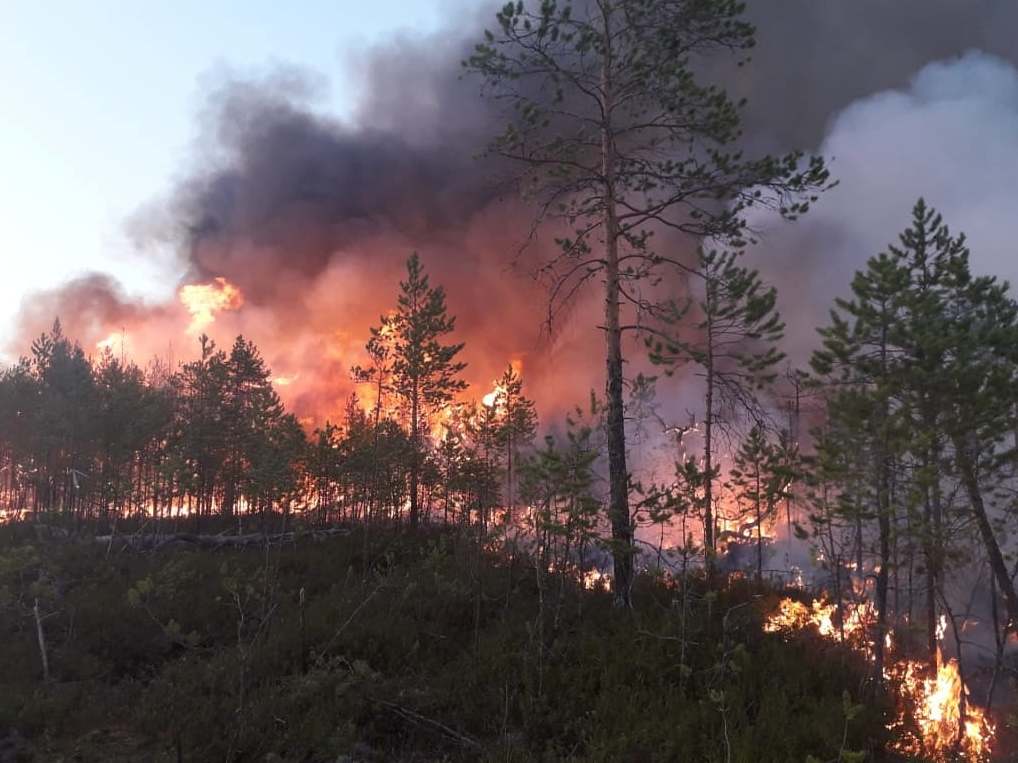Climate crisis: Out-of-control wildfires in Arctic circle released more CO2 in two months than whole of 2019
Smoke seen by satellites covering area equivalent to more than a third of Canada

Your support helps us to tell the story
From reproductive rights to climate change to Big Tech, The Independent is on the ground when the story is developing. Whether it's investigating the financials of Elon Musk's pro-Trump PAC or producing our latest documentary, 'The A Word', which shines a light on the American women fighting for reproductive rights, we know how important it is to parse out the facts from the messaging.
At such a critical moment in US history, we need reporters on the ground. Your donation allows us to keep sending journalists to speak to both sides of the story.
The Independent is trusted by Americans across the entire political spectrum. And unlike many other quality news outlets, we choose not to lock Americans out of our reporting and analysis with paywalls. We believe quality journalism should be available to everyone, paid for by those who can afford it.
Your support makes all the difference.Out-of-control wildfires north of the Arctic Circle have released more dangerous greenhouse gases in two months than all of the fires last year combined, scientists have said.
The latest data from the European Union’s Copernicus Atmosphere Monitoring Service reveals the appalling extent of the fires in the Siberian Arctic, which are releasing huge amounts of carbon dioxide (CO2) into the atmosphere.
Around 600 individual fire hotspots are being detected every day, compared with 200 to 300 on average in July 2019, and images taken by the satellites show enormous plumes of thick smoke, many stretching tens of kilometres across the tundra.
In total, smoke from the wildfires was covering an area of about 3.6 million sq km (1.4 million sq miles) on Wednesday - more than a third of the area of Canada.
“What we have been seeing in the Arctic this summer is a significant number of wildfires in the Siberian Arctic that have been burning since about the second week of June with high intensity and producing large amounts of smoke pollution covering much of the region,” Mark Parrington, senior scientist at Copernicus, told The Independent.
“In terms of CO2, we estimate that 205 megatonnes of CO2 was emitted from wildfires within the Arctic Circle between 1 June and 31 July 2020.
“For some context, the annual total wildfire emissions for the Arctic Circle in 2019 was 182 megatonnes of CO2,” he said.
This is more CO2 emissions than the annual output of Denmark, Sweden, Norway, and Finland combined.
Speaking about the increase in fires in recent years, Dr Parrington said detailed data on fires north of the Arctic circle only goes back to 2003, nonetheless, what the observations show is that up until 2019 there had been some fires in the Siberian Arctic but they have been relatively short-lived, lasting for “a few days”.
“But in 2019 and 2020 the fires have been more widespread and more persistent, burning for several weeks between June and August.
He added: “Observations are somewhat limited prior to the mid-1990s but there does not seem to be any evidence of similar fire events in the years before any routine monitoring data are available.”
The wildfires come amid a heatwave in northern Siberia, where temperatures have been 15C to 20C warmer than normal for consecutive days, forecasters said this week.
Also in Canada, a temperature of 33C was recorded north of the Arctic circle, highlighting the impact of the Arctic amplification phenomenon in which temperatures in northern polar regions have risen at least twice as fast as other parts of the globe amid the climate crisis.
According to the Moscow Times, ice cover in the Arctic Ocean hit an all-time low for this time of year on 15 July, the paper said, citing Russia’s National Snow and Ice Data Centre.
The Siberian coast is most affected, while the Northeast Passage, a sea shipping route connecting Europe with Asia, was free of ice by mid-July. Last year, it took until late August for the ice to melt and open the route.
Dr Parrington said: “The direct impact of these wildfires on the global climate is difficult to quantify but there are a number of potential indirect impacts. In terms of the CO2 emissions, some of this will be reabsorbed by the biosphere but this is a slow process and we don’t have an estimate of this right now, however, fires in peatland are releasing carbon which has been stored in the ground for thousands of years.”
He added: “Changes to the surface albedo [reflectivity], due to changes in the land surface with the burn scars and deposition of black carbon to sea ice in the Arctic Ocean could also alter how solar radiation is absorbed or reflected and affect how the climate is changing in the Arctic.”
The burning of peatlands is highly alarming to climate scientists, not only because of the CO2 emissions and changes to the albedo, but also because as the Arctic’s enormous areas of permafrost melt, they release huge stores of methane - an extremely potent greenhouse gas - further accelerating the rise in temperatures.
Join our commenting forum
Join thought-provoking conversations, follow other Independent readers and see their replies
Comments